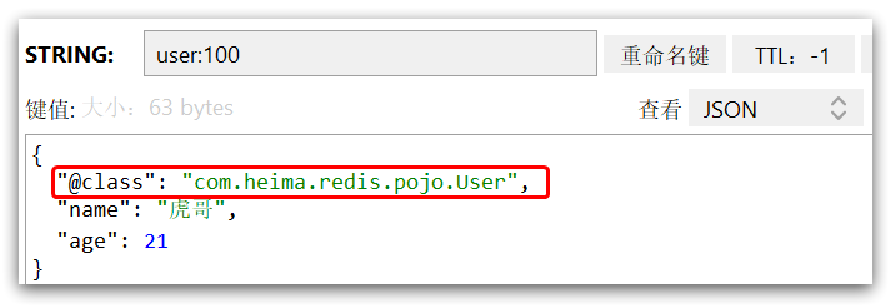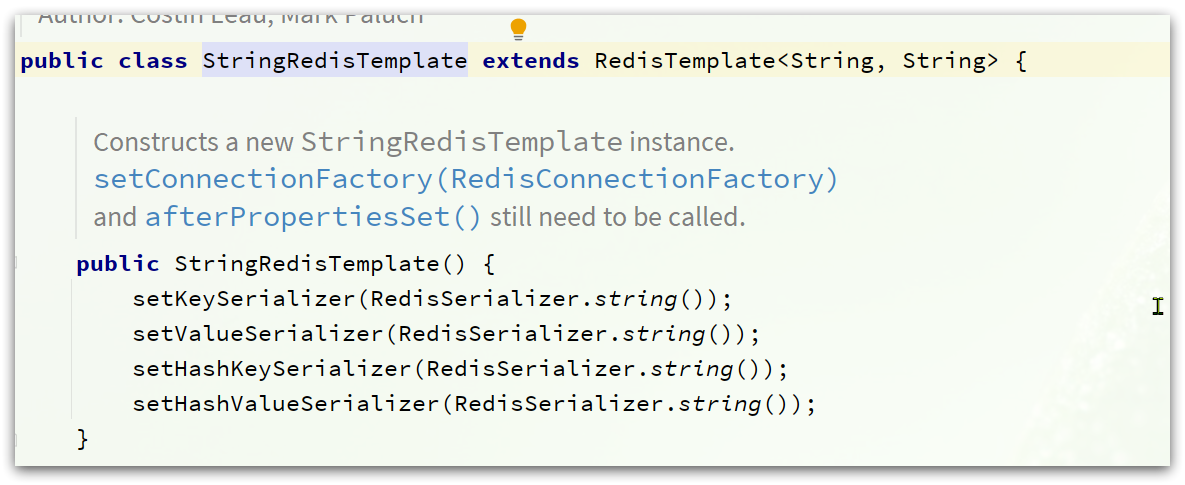 SpringDataRedis客户端
SpringDataRedis客户端
SpringData是Spring中数据操作的模块,包含对各种数据库的集成,其中对Redis的集成模块就叫做SpringDataRedis,官网地址:https://spring.io/projects/spring-data-redis
- 提供了对不同Redis客户端的整合(Lettuce和Jedis)
- 提供了RedisTemplate统一API来操作Redis
- 支持Redis的发布订阅模型
- 支持Redis哨兵和Redis集群
- 支持基于Lettuce的响应式编程
- 支持基于JDK、JSON、字符串、Spring对象的数据序列化及反序列化
- 支持基于Redis的JDKCollection实现
SpringDataRedis中提供了RedisTemplate工具类,其中封装了各种对Redis的操作。并且将不同数据类型的操作API封装到了不同的类型中:

# 快速入门
SpringBoot已经提供了对SpringDataRedis的支持,使用非常简单。
首先,新建一个maven项目,然后按照下面步骤执行:
# 1)引入依赖
<?xml version="1.0" encoding="UTF-8"?>
<project xmlns="http://maven.apache.org/POM/4.0.0" xmlns:xsi="http://www.w3.org/2001/XMLSchema-instance"
xsi:schemaLocation="http://maven.apache.org/POM/4.0.0 https://maven.apache.org/xsd/maven-4.0.0.xsd">
<modelVersion>4.0.0</modelVersion>
<parent>
<groupId>org.springframework.boot</groupId>
<artifactId>spring-boot-starter-parent</artifactId>
<version>2.5.7</version>
<relativePath/> <!-- lookup parent from repository -->
</parent>
<groupId>com.heima</groupId>
<artifactId>redis-demo</artifactId>
<version>0.0.1-SNAPSHOT</version>
<name>redis-demo</name>
<description>Demo project for Spring Boot</description>
<properties>
<java.version>1.8</java.version>
</properties>
<dependencies>
<!--redis依赖-->
<dependency>
<groupId>org.springframework.boot</groupId>
<artifactId>spring-boot-starter-data-redis</artifactId>
</dependency>
<!--common-pool-->
<dependency>
<groupId>org.apache.commons</groupId>
<artifactId>commons-pool2</artifactId>
</dependency>
<!--Jackson依赖-->
<dependency>
<groupId>com.fasterxml.jackson.core</groupId>
<artifactId>jackson-databind</artifactId>
</dependency>
<dependency>
<groupId>org.projectlombok</groupId>
<artifactId>lombok</artifactId>
<optional>true</optional>
</dependency>
<dependency>
<groupId>org.springframework.boot</groupId>
<artifactId>spring-boot-starter-test</artifactId>
<scope>test</scope>
</dependency>
</dependencies>
<build>
<plugins>
<plugin>
<groupId>org.springframework.boot</groupId>
<artifactId>spring-boot-maven-plugin</artifactId>
<configuration>
<excludes>
<exclude>
<groupId>org.projectlombok</groupId>
<artifactId>lombok</artifactId>
</exclude>
</excludes>
</configuration>
</plugin>
</plugins>
</build>
</project>
2
3
4
5
6
7
8
9
10
11
12
13
14
15
16
17
18
19
20
21
22
23
24
25
26
27
28
29
30
31
32
33
34
35
36
37
38
39
40
41
42
43
44
45
46
47
48
49
50
51
52
53
54
55
56
57
58
59
60
61
62
63
64
# 2)配置Redis
spring:
redis:
host: 192.168.150.101 #改成你自己的ip
port: 6379
password: 123321
lettuce:
pool:
max-active: 8 #最大连接
max-idle: 8 #最大空闲连接
min-idle: 0 #最小空闲连接
max-wait: 1000ms #连接等待时间
2
3
4
5
6
7
8
9
10
11
# 3)注入RedisTemplate
编写Test测试类,就是直接在test文件夹下的java.com.xxx.xxApplicationTest里面写
因为有了SpringBoot的自动装配,我们可以拿来就用:
@Autowired
private RedisTemplate redisTemplate;
2
# 4)编写测试
@SpringBootTest
class RedisStringTests {
@Autowired
private RedisTemplate redisTemplate;
@Test
void testString() {
// 写入一条String数据
redisTemplate.opsForValue().set("name", "虎哥");
// 获取string数据
Object name = stringRedisTemplate.opsForValue().get("name");
System.out.println("name = " + name);
}
}
2
3
4
5
6
7
8
9
10
11
12
13
14
15
# 快速入门总结
贴心小提示:SpringDataJpa使用起来非常简单,记住如下几个步骤即可
SpringDataRedis的使用步骤:
- 引入spring-boot-starter-data-redis依赖
- 在application.yml配置Redis信息
- 注入RedisTemplate到IoC容器中
- 通过RedisTemplate来set赋值,get取值
# 注意项
使用SpringDataRedis,最终还是通过RedisTemplate来与Redis进行交互
RedisTemplate可以接收任意类型的对象
提示
原理就是将Object转成Redis可以接收的字节,因此set所存入的key和value都被当成java对象了
RedisTemplate底层将这些对像,利用JDK的序列化器进行序列化或反序列化进行存储或读取。

# 默认序列化的弊端
写入Redis之前会把Object序列化为字节形式,默认是采用JDK序列化,得到的结果是这样的:

警告
缺点:
- 可读性差 不能所见即所得
- 内存占用较大 序列化后又臭又长
# 自定义序列化
既然默认RedisTemplate的序列化方式如此不好
我们可以自定义RedisTemplate的序列化方式,代码如下:
@Configuration
public class RedisConfig {
@Bean
public RedisTemplate<String, Object> redisTemplate(RedisConnectionFactory connectionFactory){
// 创建RedisTemplate对象
RedisTemplate<String, Object> template = new RedisTemplate<>();
// 设置连接工厂
template.setConnectionFactory(connectionFactory);
// 创建JSON序列化工具
GenericJackson2JsonRedisSerializer jsonRedisSerializer =
new GenericJackson2JsonRedisSerializer();
// 设置Key的序列化
template.setKeySerializer(RedisSerializer.string());
template.setHashKeySerializer(RedisSerializer.string());
// 设置Value的序列化
template.setValueSerializer(jsonRedisSerializer);
template.setHashValueSerializer(jsonRedisSerializer);
// 返回
return template;
}
}
2
3
4
5
6
7
8
9
10
11
12
13
14
15
16
17
18
19
20
21
22
这里采用了JSON序列化来代替默认的JDK序列化方式。最终结果如图:

整体可读性有了很大提升,并且能将Java对象自动的序列化为JSON字符串,并且查询时能自动把JSON反序列化为Java对象。不过,其中记录了序列化时对应的class名称,目的是为了查询时实现自动反序列化。
警告
为了在反序列化时知道对象的类型,JSON序列化器会将类的class类型写入json结果中,存入Redis,会带来额外的内存开销。
# StringRedisTemplate
尽管JSON的序列化方式可以满足我们的需求,但依然存在一些问题,如图:

为了节省内存空间,我们可以不使用JSON序列化器来处理value,而是统一使用String序列化器,要求只能存储String类型的key和value。当需要存储Java对象时,手动完成对象的序列化和反序列化。

因为存入和读取时的序列化及反序列化都是我们自己实现的,SpringDataRedis就不会将class信息写入Redis了。
这种用法比较普遍,因此SpringDataRedis就提供了RedisTemplate的子类:StringRedisTemplate,它的key和value的序列化方式默认就是String方式。

省去了我们自定义RedisTemplate的序列化方式的步骤,而是直接使用:
@Autowired
private StringRedisTemplate stringRedisTemplate;
// JSON序列化工具
private static final ObjectMapper mapper = new ObjectMapper();
@Test
void testSaveUser() throws JsonProcessingException {
// 创建对象
User user = new User("虎哥", 21);
// 手动序列化
String json = mapper.writeValueAsString(user);
// 写入数据
stringRedisTemplate.opsForValue().set("user:200", json);
// 获取数据
String jsonUser = stringRedisTemplate.opsForValue().get("user:200");
// 手动反序列化
User user1 = mapper.readValue(jsonUser, User.class);
System.out.println("user1 = " + user1);
}
2
3
4
5
6
7
8
9
10
11
12
13
14
15
16
17
18
19
20
21
此时我们再来看一看存储的数据,小伙伴们就会发现那个class数据已经不在了,节约了我们的空间~

# 总结:
RedisTemplate的两种序列化实践方案:
方案一:
- 自定义RedisTemplate
- 可读性差
- 内存占用大
- 修改RedisTemplate的序列化器为GenericJackson2JsonRedisSerializer
- 为了自动反序列化,JSON序列化器会将类的class类型写入json结果中
- 给Redis带来额外的内存开销
- 自定义RedisTemplate
方案二:
- 使用StringRedisTemplate
- 写入Redis时,手动把对象序列化为JSON
- 读取Redis时,手动把读取到的JSON反序列化为对象
- 使用StringRedisTemplate
# Hash结构操作
hash操作就是一个key可以对应多个字段的值。
在基础篇的最后,咱们对Hash结构操作一下,收一个小尾巴,这个代码咱们就不再解释啦
@SpringBootTest
class RedisStringTests {
@Autowired
private StringRedisTemplate stringRedisTemplate;
@Test
void testHash() {
stringRedisTemplate.opsForHash().put("user:400", "name", "虎哥");
stringRedisTemplate.opsForHash().put("user:400", "age", "21");
Map<Object, Object> entries = stringRedisTemplate.opsForHash().entries("user:400");
System.out.println("entries = " + entries);
}
}
2
3
4
5
6
7
8
9
10
11
12
13
14
15
马上就开始新的篇章~~~进入到我们的Redis实战篇
